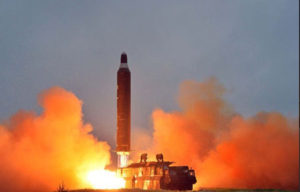
|
On June 22, North Korea fired a Musudan intermediate-range ballistic missile from Wonsan, the sixth firing this year, but considered only the first acceptable launch.
The missile flew to an altitude 1414 kilometers and had a range of 400 kilometers. The U.S. Department of Defense on Monday acknowledged that the missile had reentered the atmosphere from space. Whether the missile is a threat to South Korean and U.S. bases in the Pacific Ocean is still controversial among experts. But it is believed North Korea still has some kinks to work out before the missile can be deployed. Experts say the Musudan’s speed was slow enough to be intercepted by certain missile defense systems. They also say the missile did not reach a minimum speed of Mach 20 (20 times the speed of sound) and it uses outdated thrust technology. The missile’s biggest weakness is that it can be intercepted. The U.S. Terminal High Altitude Area Defense (THAAD) system could intercept the missile at an altitude of 140 kilometers to 150 kilometers flying at up to Mach 14. Considering the Musudan traveled at Mach 10 to 11 at an altitude of 100 kilometers, experts say it is possible to be intercepted. It is also known that the SM-3 missile defense system aboard U.S. Aegis destroyers can intercept the Musudan at all altitudes and that Korean Aegis destroyers can be equipped with the system. Although no negotiation on a SM-3 missile system is under way, South Korea is negotiating a THAAD deal with the U.S. |
